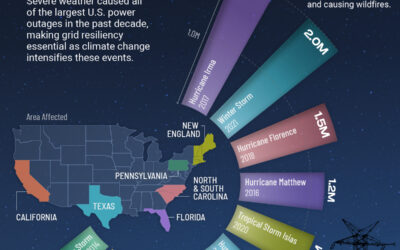Ranked: America’s Cheapest Sources of Electricity in 2024
In the evolving global energy landscape, renewable sources are becoming increasingly cost effective. Even without subsidies, renewables are often the cheapest option available.
This chart, created in partnership with the National Public Utilities Council, shows which electricity sources are the most and least expensive in 2024, using data by Lazard.
Onshore Wind and Solar: A Bargain with Subsidies
Onshore wind power effectively costs $0 per megawatt-hour (MWh) when subsidies included in the Inflation Reduction Act, such as the Investment Tax Credit, Production Tax Credit, and Energy Community Adder, are applied.
Demand for storage solutions is rising quickly. If storage is included, the minimum cost for onshore wind increases to $8 per MWh. Offshore wind, while more expensive, still presents a competitive option at a minimum of $71 per MWh with subsidies.
Solar photovoltaics (PV) have similarly attractive economics.
With subsidies, the minimum cost is $6 per MWh. When including storage, $38 per MWh. Notably, the maximum cost of solar PV with storage has significantly increased from $102 in 2023 to $210 in 2024, although the cost of solar alone is still 83% cheaper in 2024 than it was in 2009, according to Lazard.
The inflation of 2022–2023 took a toll on solar PV and onshore wind, pushing their maximum unsubsidized costs back up to where they were in 2013 and 2015, respectively. However, solar PV dropped by $4 and onshore wind by $2 from 2023–2024.
Fossil Fuels
For gas-combined cycle plants, which combine natural gas and steam turbines for efficient electricity generation, the maximum price has climbed $7 year-over-year to $108 per MWh.
Gas peaking plants, used to meet peak electricity demands, remain the most expensive option with a maximum cost of $228 per MWh. Interestingly, the minimum price for these plants has seen a slight dip from $115 to $110 per MWh compared to last year.
The Strange Case of Nuclear Energy
Nuclear energy presents a unique cost structure with the highest minimum cost among all energy sources at $142 per MWh.
However, the economics improve significantly with lifetime extensions of nuclear plants. These extensions reduce the minimum marginal cost of nuclear electricity to $32 per MWh, a cost reduction that 95% of U.S. nuclear plants benefit from.
The cost dynamics of energy production are shifting towards renewables, driven by market forces, technological advancements, and government subsidies, according to Lazard. As renewables become cheaper, they are poised to play a dominant role in the future energy mix, providing both economic and environmental benefits.
Learn more about how electric utilities and the power sector can lead on the path toward decarbonization here.






